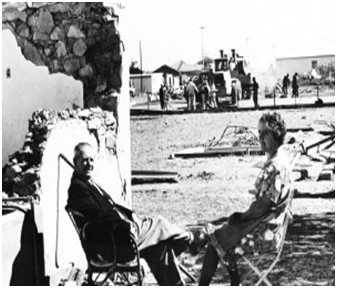This Day in History: September 29, 1969
Additional Date: September 29, 1969
At about 10:04pm on 29 September 1969, the Boland farming towns of Tulbagh, Wolseley and Ceres experienced the most destructive earthquake in South African history.[i] The epicentre of the earthquake was situated in Saron, a region near Tulbagh. The earthquake measured a sizable 6.3 on the Richter’s scale, with reports of tremors experienced in the broader Cape region.[ii] Earthquakes in the area were relatively unheard of before then. Because of a general lack of knowledge about earthquakes at the time, precautionary measures and disaster management were not in place.[iii] As a result the Tulbagh earthquake resulted in nine human casualties and several injuries.[iv] In addition many homes in the town were rendered uninhabitable. The earthquake wreaked destruction on the older, more historically significant, buildings in the area. One of the greatest casualties in terms of heritage was the La Rhone farm house, built in 1785, which was unfortunately damaged beyond repair.[v] Restoration programmes were immediately orchestrated to help facilitate rebuilding of the towns. Restoration programmes were specifically successful in Kerk Straat, Tulbagh, a street where the oldest buildings in town can be found.[vi] Numerous organisations set up disaster funds, as all South Africans sympathised with the residents of Tulbagh, Ceres and Wolseley.[vii] Endnotes [i] Kijko, A., Retief, S.J.P. & Graham, G. 2002. Seismic Hazard and Risk Assessment for Tulbagh, South Africa: Part I – Assessment of Seismic Hazard. Natural Hazards, 26(1): p. 175-201. Pretoria: Council of Geoscience.↵ [ii] Kijko, A., Retief, S.J.P. & Graham, G. 2002. Seismic Hazard and Risk Assessment for Tulbagh, South Africa: Part I – Assessment of Seismic Hazard. Natural Hazards, 26(1): p. 175-201. Pretoria: Council of Geoscience.↵ [iii] Kijko, A., Retief, S.J.P. & Graham, G. 2002. Seismic Hazard and Risk Assessment for Tulbagh, South Africa: Part I – Assessment of Seismic Hazard. Natural Hazards, 26(1): p. 175-201. Pretoria: Council of Geoscience.↵ [iv] Kijko, A., Retief, S.J.P. & Graham, G. 2002. Seismic Hazard and Risk Assessment for Tulbagh, South Africa: Part I – Assessment of Seismic Hazard. Natural Hazards, 26(1): p. 175-201. Pretoria: Council of Geoscience.↵ [v] Kijko, A., Retief, S.J.P. & Graham, G. 2002. Seismic Hazard and Risk Assessment for Tulbagh, South Africa: Part I – Assessment of Seismic Hazard. Natural Hazards, 26(1): p. 175-201. Pretoria: Council of Geoscience.↵ [vi] Kijko, A., Retief, S.J.P. & Graham, G. 2002. Seismic Hazard and Risk Assessment for Tulbagh, South Africa: Part I – Assessment of Seismic Hazard. Natural Hazards, 26(1): p. 175-201. Pretoria: Council of Geoscience.↵ [vii] Kijko, A., Retief, S.J.P. & Graham, G. 2002. Seismic Hazard and Risk Assessment for Tulbagh, South Africa: Part I – Assessment of Seismic Hazard. Natural Hazards, 26(1): p. 175-201. Pretoria: Council of Geoscience.↵
